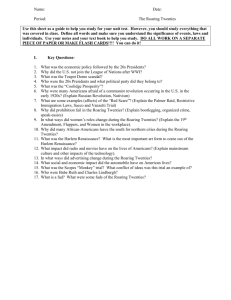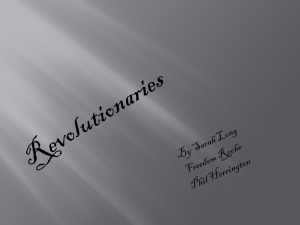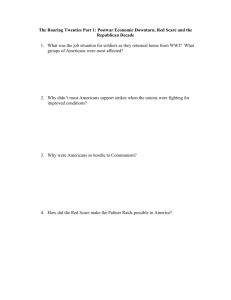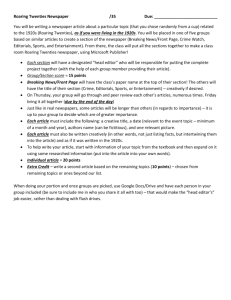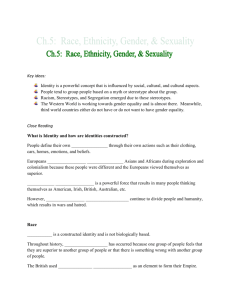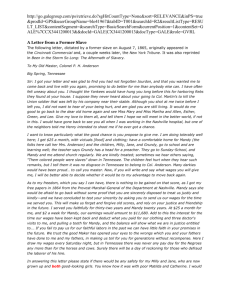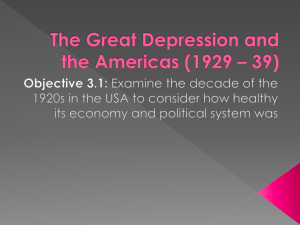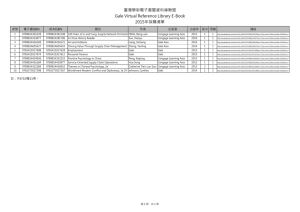Roaring Twenties: 1919–29
advertisement
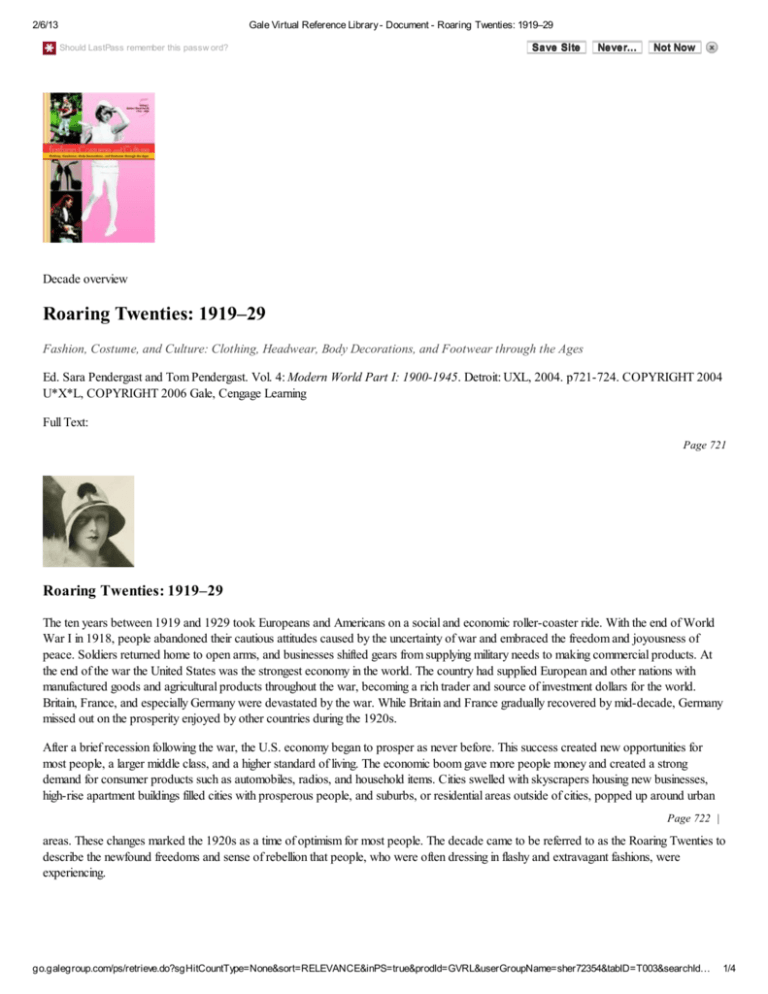
2/6/13 Gale Virtual Reference Library - Document - Roaring Twenties: 1919–29 Should LastPass remember this passw ord? Save Site Never... Not Now Decade overview Roaring Twenties: 1919–29 Fashion, Costume, and Culture: Clothing, Headwear, Body Decorations, and Footwear through the Ages Ed. Sara Pendergast and Tom Pendergast. Vol. 4: Modern World Part I: 1900-1945. Detroit: UXL, 2004. p721-724. COPYRIGHT 2004 U*X*L, COPYRIGHT 2006 Gale, Cengage Learning Full Text: Page 721 Roaring Twenties: 1919–29 The ten years between 1919 and 1929 took Europeans and Americans on a social and economic roller-coaster ride. With the end of World War I in 1918, people abandoned their cautious attitudes caused by the uncertainty of war and embraced the freedom and joyousness of peace. Soldiers returned home to open arms, and businesses shifted gears from supplying military needs to making commercial products. At the end of the war the United States was the strongest economy in the world. The country had supplied European and other nations with manufactured goods and agricultural products throughout the war, becoming a rich trader and source of investment dollars for the world. Britain, France, and especially Germany were devastated by the war. While Britain and France gradually recovered by mid-decade, Germany missed out on the prosperity enjoyed by other countries during the 1920s. After a brief recession following the war, the U.S. economy began to prosper as never before. This success created new opportunities for most people, a larger middle class, and a higher standard of living. The economic boom gave more people money and created a strong demand for consumer products such as automobiles, radios, and household items. Cities swelled with skyscrapers housing new businesses, high-rise apartment buildings filled cities with prosperous people, and suburbs, or residential areas outside of cities, popped up around urban Page 722 | areas. These changes marked the 1920s as a time of optimism for most people. The decade came to be referred to as the Roaring Twenties to describe the newfound freedoms and sense of rebellion that people, who were often dressing in flashy and extravagant fashions, were experiencing. go.galegroup.com/ps/retrieve.do?sgHitCountType=None&sort=RELEVANCE&inPS=true&prodId=GVRL&userGroupName=sher72354&tabID=T003&searchId… 1/4 2/6/13 Gale Virtual Reference Library - Document - Roaring Twenties: 1919–29 With more money in their pockets, people could afford to spend more on luxury items and tried to adopt more glamorous looks. Reproduced by permission of © Bettmann/CORBIS. Full Text: Women want more As the world shifted from focusing on the war to recreating normal domestic habits, however, the changes the war brought became very noticeable. Some things, people realized, would never be the same. When men had gone off to war in the 1910s, women had taken their places in factories and businesses. Over the four years of the war, women had become adept at earning a living outside the home. They did not want to leave their jobs when soldiers came back. And with the death of so many men during the war, some women were forced to continue supporting their families without the help of a man. The struggle to decide whether women would return to their old ways of life or to keep on with their newfound independence was another battle in the long campaign for women's rights. In the United States it led directly to women earning the right to vote in 1920. Education Throughout the 1920s education became a focus for youth and young adults alike. Increases in government and private funding allowed schools and colleges to offer more people a solid education than ever before. The increase in education also increased the participation in sports such as swimming, tennis, golf, and horseback riding that became part of college sports programs. With the increase in the wealth of the middle class, more young men and women could afford to go to college to train for better jobs. In the United States more than 150,000 college degrees were awarded to graduates by the end of the 1920s. The popularity of a college education during the decade focused Page 723 | attention on youth and new styles emerged on college campuses throughout the United States and Europe. go.galegroup.com/ps/retrieve.do?sgHitCountType=None&sort=RELEVANCE&inPS=true&prodId=GVRL&userGroupName=sher72354&tabID=T003&searchId… 2/4 2/6/13 Gale Virtual Reference Library - Document - Roaring Twenties: 1919–29 Rebellious young women of the 1920s often adopted several outrageous fashion fads. Reproduced by permission of © Bettmann/CORBIS. Affordable luxury Other changes altered everyday life in Europe and the United States. With a prospering economy and high employment, more people than ever had money to spend on entertainment. Automobiles were the most attractive luxury item, and anyone who could afford one had one. The Ford Motor Company had around ten thousand dealerships across the United States by 1924. People, especially Americans, hopped in their cars to explore their country, camping alongside the roads or staying in hotels at distant locations. Cars also offered people the opportunity to commute to work in the city from their homes in quiet suburbs or in housing developments surrounding urban areas. Radios gave people the opportunity to hear news about the world and became increasingly popular for entertainment. By 1925 music dominated 70 percent of the radio airwaves and reached more than 2.5 million American radio listeners. Other entertainment included films and music. People rushed to movie theaters to see the latest films; their popularity made movie actors and actresses into stars. A new type of music called jazz developed in the United States, inspiring new wild dance moves. And people could spend their money at newly constructed retail stores. By 1927 there were seventy thousand different retail locations throughout the United States, including A&P grocery stores, J.C. Penney department stores, Walgreen drugstores, and Fanny Farmer candy stores. The beginning of Prohibition, an amendment to the U.S. Constitution in 1919 that made the manufacture, sale, or transportation of alcohol illegal, did not stop the energetic optimism of the decade, nor did it stop people from drinking. Although some Americans were happy to have Page 724 | a "dry," or alcohol-free, nation, many others supported the creation of speakeasies, illegal places selling alcohol and usually offering live music, dancing, and gambling, for late-night entertainment. So many speakeasies popped up around the country that the police could not effectively enforce Prohibition. By 1926 the sale of alcohol in the United States was estimated to be worth $3.6 billion, making many bootleggers, or people involved in the illegal manufacture and trade of alcohol, millionaires. The relaxed feeling in the economy was fueled by governmental policies that let businesses grow and compete without much regulation. This, coupled with banking procedures that offered good terms to borrowers but little protection for investors, led to risky financial deals and the growth of many new companies. By the end of the decade the optimism that had inspired the creation of new businesses and investments could no longer sustain the economy and many businesses began to fail. With the stock market crash on October 24, 1929, a new era began: the Great Depression of the 1930s. FOR MORE INFORMATION Allen, Frederick Lewis. Only Yesterday: An Informal History of the 1920s. New York: Harper and Brothers, 1931. Reprint, New York: Wiley, 1997. Hanson, Erica. The 1920s. San Diego, CA: Lucent Books, 1999. Katz, William Loren. The New Freedom to the New Deal, 1913–1939. Austin, TX: Raintree Steck-Vaughn, 1993. go.galegroup.com/ps/retrieve.do?sgHitCountType=None&sort=RELEVANCE&inPS=true&prodId=GVRL&userGroupName=sher72354&tabID=T003&searchId… 3/4 2/6/13 Gale Virtual Reference Library - Document - Roaring Twenties: 1919–29 Clothing, 1919–29 Headwear, 1919–29 Body Decorations, 1919–29 Footwear, 1919–29 Source Citation (MLA 7th Edition) "Roaring Twenties: 1919–29." Fashion, Costume, and Culture: Clothing, Headwear, Body Decorations, and Footwear through the Ages. Ed. Sara Pendergast and Tom Pendergast. Vol. 4: Modern World Part I: 1900-1945. Detroit: UXL, 2004. 721-724. Gale Virtual Reference Library. Web. 6 Feb. 2013. Document URL http://go.galegroup.com/ps/i.do?id=GALE%7CCX3425500471&v=2.1&u=sher72354&it=r&p=GVRL&sw=w Gale Document Number: GALE|CX3425500471 go.galegroup.com/ps/retrieve.do?sgHitCountType=None&sort=RELEVANCE&inPS=true&prodId=GVRL&userGroupName=sher72354&tabID=T003&searchId… 4/4
